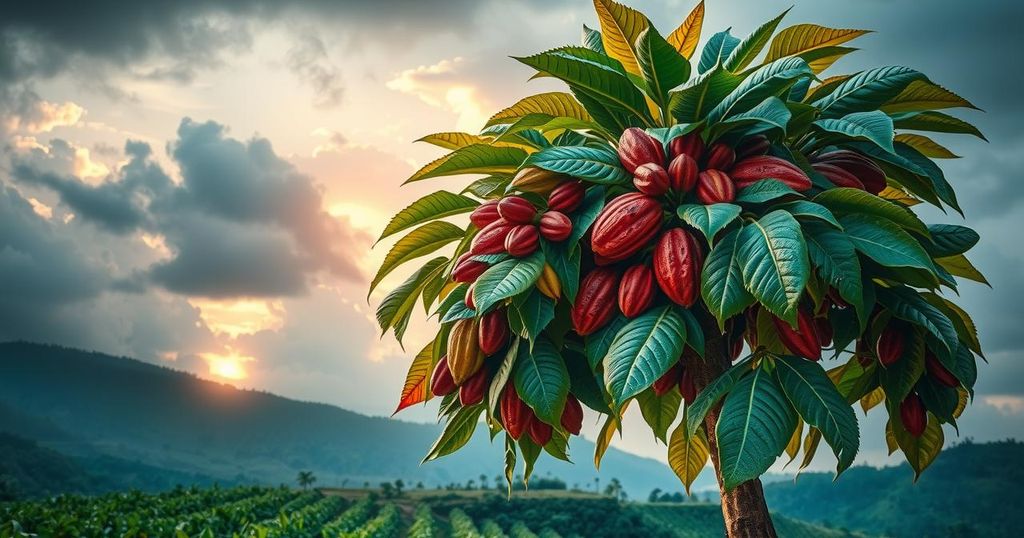The Impact of Climate Change on Valentine’s Day Chocolate Prices
Americans are projected to spend over $27.5 billion on Valentine’s Day in 2024, with a significant portion on chocolate. Cocoa production is declining due to climate change, causing prices to rise. Cacao trees require specific conditions to thrive, which are increasingly threatened. Adaptation strategies and sustainable consumer choices are crucial to support cocoa farmers and mitigate these challenges. As cocoa prices soar, ethical sourcing becomes vital for consumers.
Every year, American expenditures on Valentine’s Day increase significantly, with 2023’s spending reaching nearly $26 billion and expectations for 2024 exceeding $27.5 billion. A substantial portion of this expenditure is allocated to candy, including chocolate, which constitutes 11.2% of that spend. Approximately 58 million pounds of chocolate are consumed each Valentine’s week, yet cocoa production is declining, resulting in rising chocolate prices. Professor Jessica Fanzo of the Columbia Climate School’s Food for Humanity Initiative discusses the challenges facing cacao trees due to climate change.
Cacao trees primarily flourish in tropical regions surrounding the equator, including Southeast Asia, Central and South America, and West Africa. Notably, West Africa is responsible for about 70% of global cocoa production. For cacao trees to thrive, they require warm temperatures, high humidity, and consistent rainfall. However, climate change jeopardizes these conditions, presenting significant challenges for cocoa farmers who require time and specific expertise to cultivate cacao effectively.
The impacts of climate change on cocoa production are profound, manifesting in erratic weather patterns, droughts, and excessive rainfall which all hinder yields. Since cacao trees depend on stable rainfall, drought periods can cause significant water stress, while excess rain may lead to fungal diseases affecting the pods. Rising temperatures exacerbate moisture loss from the soil, further endangering traditional cocoa cultivation in West Africa and causing some farmers to relocate to higher altitudes.
Farmers are adapting to these climate challenges by cultivating new drought-resistant cocoa varieties being developed in regions like Ghana and Brazil. Additionally, implementing mixed agroforestry systems—integrating cocoa with shade and fruit trees—can help moderate temperatures and preserve soil moisture. Proper soil and water management strategies, including rainwater harvesting, irrigation, and mulching, are also essential to sustain cocoa production amid climatic stress.
Consumers can drive sustainable practices by purchasing ethically sourced chocolate with recognized sustainability certifications. These certifications indicate that manufacturers support environmentally responsible farming practices that also ensure fair wages for farmers. Additionally, consumers should seek brands that specialize in agroforestry methods, such as shade-grown cocoa, promoting not only sustainability but also fair labor practices.
The surge in cocoa prices is attributable to reduced cocoa yields in major producing countries like Cote D’Ivoire and Ghana, driven by climatic events and disease. Over the past two years, cocoa prices have escalated by over 300%, influenced by market speculation and insufficient tree planting to improve yields. Thus, consumers may need to prepare for higher costs when purchasing chocolate for their loved ones this Valentine’s Day.
In summary, climate change presents significant challenges to cocoa production, affecting the thriving conditions of cacao trees, which rely on stable climates. Adaptation strategies, improved agricultural practices, and consumer awareness regarding sustainable purchasing play critical roles in mitigating these effects. As cocoa prices rise due to diminished yields, consumers are encouraged to support ethical sourcing to foster a positive environmental impact and sustainable livelihoods for farmers.
Original Source: news.climate.columbia.edu




Post Comment